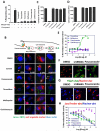Synergistic drug combination effectively blocks Ebola virus infection
- PMID: 27890675
- PMCID: PMC5182099
- DOI: 10.1016/j.antiviral.2016.11.017
Synergistic drug combination effectively blocks Ebola virus infection
Abstract
Although a group of FDA-approved drugs were previously identified with activity against Ebola virus (EBOV), most of them are not clinically useful because their human blood concentrations are not high enough to inhibit EBOV infection. We screened 795 unique three-drug combinations in an EBOV entry assay. Two sets of three-drug combinations, toremifene-mefloquine-posaconazole and toremifene-clarithromycin-posaconazole, were identified that effectively blocked EBOV entry and were further validated for inhibition of live EBOV infection. The individual drug concentrations in the combinations were reduced to clinically relevant levels. We identified mechanisms of action of these drugs: functional inhibitions of Niemann-Pick C1, acid sphingomyelinase, and lysosomal calcium release. Our findings identify the drug combinations with potential to treat EBOV infection.
Keywords: Drug combination; Drug repurposing; Ebola prevention; Ebola treatment; Polypharmacology.
Published by Elsevier B.V.
Figures



References
-
- Clarithromycin. Tuberculosis (Edinb) 2008;88:92–95. - PubMed
-
- Abramowicz M, Zuccotti G, Pflomm JM. A 4-Drug Combination (Viekira Pak) for Hepatitis C. Jama-J Am Med Assoc. 2015;313:1857–1858. - PubMed
-
- Amini H, Ahmadiani A. Sensitive determination of clarithromycin in human plasma by high-performance liquid chromatography with spectrophotometric detection. J Chromatogr B Analyt Technol Biomed Life Sci. 2005;817:193–197. - PubMed
-
- Andersson DI, Hughes D. Antibiotic resistance and its cost: is it possible to reverse resistance? Nat Rev Microbiol. 2010;8:260–271. - PubMed
MeSH terms
Substances
Grants and funding
LinkOut - more resources
Full Text Sources
Other Literature Sources
Medical

